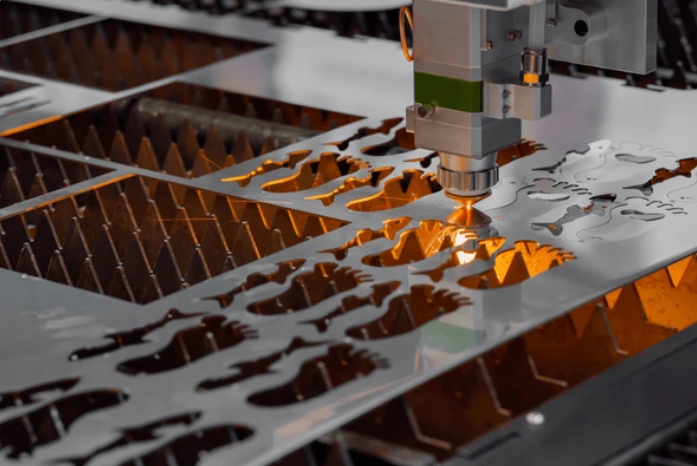Nesting Fundamentals for Laser Cutting Stability: A Comprehensive Guide

Nesting Fundamentals for Laser Cutting Stability: A Comprehensive Guide
Laser cutting is an advanced technology that uses a high-powered laser beam to cut through materials with precision and speed. The accuracy and efficiency of laser cutting depend heavily on the quality of the nest layout, which is the process of arranging and optimizing the parts to be cut on a sheet of material. Proper nesting not only ensures material efficiency but also enhances the stability of the laser cutting process.
In this blog, we’ll explore the fundamentals of nesting for laser cutting stability, offering insights into how you can optimize your cuts, reduce waste, and improve overall production efficiency.
1. What is Nesting in Laser Cutting?
Nesting is the process of arranging multiple shapes or parts on a flat sheet of material to maximize the use of space and minimize scrap. The goal of nesting is to fit the maximum number of parts within the material’s dimensions while considering factors such as the laser cutting path, material thickness, and the specific properties of the material being used.
For laser cutting, nesting should be done with attention to the specific parameters of the cutting process. These include:
- Cutting speed
- Laser power
- Material type and thickness
- Kerf width (the width of the cut made by the laser)
- Grain direction (for metals, grains can influence cutting)
Good nesting also takes into account the positioning of parts to ensure that the laser moves smoothly and efficiently, without unnecessary retractions or path overlaps.
2. The Role of Stability in Laser Cutting
Stability in laser cutting refers to how consistently and accurately the laser cutting machine can perform the operation throughout the process. Any instability, whether it comes from the laser itself, the material, or the nesting arrangement, can result in problems such as:
- Inconsistent cuts – Uneven cutting quality due to variations in laser power, speed, or material position.
- Increased wear on equipment – A poorly optimized nest can lead to more strain on the machine, increasing maintenance costs and decreasing the life of the laser.
- Material waste – Poor nesting often leads to excess scrap and unused material, making the process less cost-effective.
- Longer cycle times – If parts aren’t arranged optimally, the machine may take longer to finish cutting, reducing overall production speed.
3. Key Principles for Stable Nesting in Laser Cutting
To ensure stability and optimize the performance of your laser cutting process, consider the following nesting principles:
A. Optimize Material Usage
One of the key factors in nesting is maximizing material usage. This involves reducing the amount of scrap and increasing the number of parts per sheet. A well-optimized nest layout will allow for:
- Tight packing: Arranging parts as close as possible to minimize material waste.
- Efficient part orientation: Rotating or flipping parts to reduce empty spaces without compromising on cut quality.
B. Minimize Travel Paths
Long travel paths between cuts can slow down the laser cutting process and increase wear on the machine. To achieve stability:
- Group parts intelligently: Cluster similar parts together to reduce travel time between different cuts.
- Reduce lift-off times: Ensure that the laser head doesn’t have to lift off between cuts too frequently. This not only saves time but also prevents unnecessary machine movements that can lead to misalignment.
C. Account for Kerf Width
The kerf width refers to the material that is vaporized during cutting, leaving a gap that can affect the overall precision. When nesting:
- Factor in kerf width: Ensure that parts are spaced sufficiently apart, accounting for the width of the laser beam to prevent the cutting edges from merging.
- Use software to calculate kerf: Many nesting software tools include kerf compensation features that can automatically adjust part dimensions to ensure accurate cutting.
D. Grain Direction Considerations (For Metals)
In metal cutting, the grain direction can influence how the laser interacts with the material. Always pay attention to:
- Aligning parts along the grain: This can enhance cutting quality and reduce issues with thermal distortion.
- Avoiding cross-grain cuts: Cutting against the grain can cause irregularities or increased resistance during the cutting process.
E. Leave Proper Gaps for Support
For larger or delicate parts, proper gaps are needed to keep the material from shifting or warping during cutting. These gaps, also known as “supports,” help maintain the stability of the cutting process:
- Support structures: Place parts where supports are most needed to maintain rigidity.
- Adjust cut strategy: For thin or delicate materials, use slower speeds or reduce power to prevent warping during cutting.
4. How to Achieve Stability Through Advanced Nesting Software
Using advanced nesting software can dramatically improve both the efficiency and stability of your laser cutting operations. Here’s how:
A. Automated Nesting
Modern nesting software utilizes algorithms to automatically arrange parts within the material’s boundaries, optimizing for:
- Minimum material usage
- Optimal cutting paths
- Reduced machine movement
B. Simulation and Testing
Before actually cutting the material, simulation features allow you to visualize and test the nested layout. You can check for issues such as:
- Overlapping parts
- Excessive travel paths
- Unstable parts that may warp or shift
By using simulation tools, you can ensure a high degree of stability and accuracy before cutting begins.
C. Integration with CAD/CAM Systems
Nesting software integrated with CAD/CAM systems helps streamline the entire design-to-production process. This ensures that the nesting layout is perfectly matched with the actual design and cutting specifications, minimizing human error and ensuring consistency.
5. Best Practices for Stable Laser Cutting
To achieve the best results, adhere to the following best practices:
- Regular maintenance of the laser cutter: Keep the machine in optimal condition by performing regular maintenance, cleaning, and calibration.
- Proper material handling: Store materials flat and avoid warping or bending that could lead to cutting issues.
- Operator training: Ensure that operators are trained to understand the implications of nesting on cutting stability and how to use nesting software efficiently.
- Quality control: Consistently monitor the quality of the cuts throughout the process and make adjustments as needed.
Conclusion
Nesting is a crucial step in the laser cutting process that directly impacts both the efficiency and stability of the operation. By optimizing part placement, considering material properties, and leveraging advanced software tools, manufacturers can improve cut quality, reduce waste, and enhance machine stability. Implementing these nesting fundamentals not only contributes to a more cost-effective production process but also ensures that every laser cut is as precise and stable as possible.
Whether you're working with metals, plastics, or other materials, taking the time to master nesting fundamentals is essential for maintaining the high quality and efficiency of your laser cutting operations.
